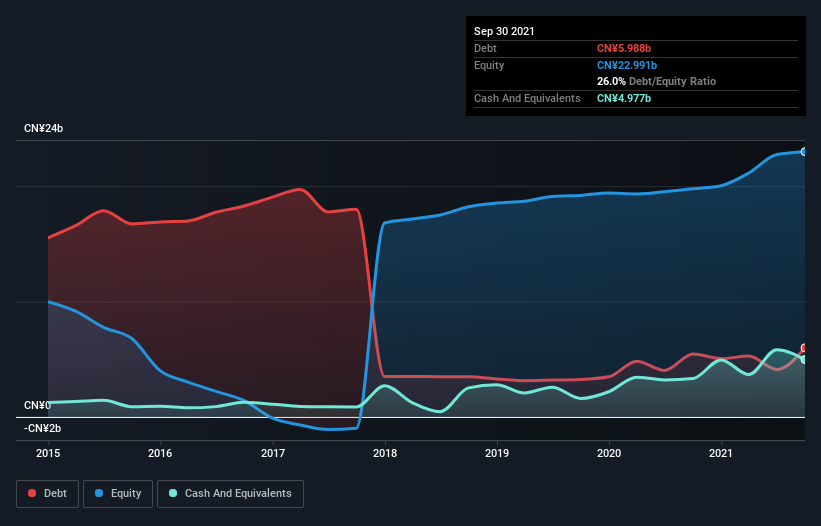- Hong Kong
- /
- Metals and Mining
- /
- SEHK:1053
Does Chongqing Iron & Steel (HKG:1053) Have A Healthy Balance Sheet?

Some say volatility, rather than debt, is the best way to think about risk as an investor, but Warren Buffett famously said that 'Volatility is far from synonymous with risk.' It's only natural to consider a company's balance sheet when you examine how risky it is, since debt is often involved when a business collapses. We can see that Chongqing Iron & Steel Company Limited (HKG:1053) does use debt in its business. But the more important question is: how much risk is that debt creating?
Why Does Debt Bring Risk?
Debt assists a business until the business has trouble paying it off, either with new capital or with free cash flow. In the worst case scenario, a company can go bankrupt if it cannot pay its creditors. However, a more frequent (but still costly) occurrence is where a company must issue shares at bargain-basement prices, permanently diluting shareholders, just to shore up its balance sheet. By replacing dilution, though, debt can be an extremely good tool for businesses that need capital to invest in growth at high rates of return. When we examine debt levels, we first consider both cash and debt levels, together.
Check out our latest analysis for Chongqing Iron & Steel
What Is Chongqing Iron & Steel's Net Debt?
The image below, which you can click on for greater detail, shows that at September 2021 Chongqing Iron & Steel had debt of CN¥5.99b, up from CN¥5.45b in one year. On the flip side, it has CN¥4.98b in cash leading to net debt of about CN¥1.01b.

A Look At Chongqing Iron & Steel's Liabilities
According to the last reported balance sheet, Chongqing Iron & Steel had liabilities of CN¥13.5b due within 12 months, and liabilities of CN¥5.14b due beyond 12 months. Offsetting these obligations, it had cash of CN¥4.98b as well as receivables valued at CN¥1.85b due within 12 months. So its liabilities outweigh the sum of its cash and (near-term) receivables by CN¥11.8b.
This deficit is considerable relative to its market capitalization of CN¥17.7b, so it does suggest shareholders should keep an eye on Chongqing Iron & Steel's use of debt. Should its lenders demand that it shore up the balance sheet, shareholders would likely face severe dilution.
We measure a company's debt load relative to its earnings power by looking at its net debt divided by its earnings before interest, tax, depreciation, and amortization (EBITDA) and by calculating how easily its earnings before interest and tax (EBIT) cover its interest expense (interest cover). Thus we consider debt relative to earnings both with and without depreciation and amortization expenses.
Chongqing Iron & Steel's net debt is only 0.22 times its EBITDA. And its EBIT covers its interest expense a whopping 10.4 times over. So we're pretty relaxed about its super-conservative use of debt. Even more impressive was the fact that Chongqing Iron & Steel grew its EBIT by 573% over twelve months. That boost will make it even easier to pay down debt going forward. There's no doubt that we learn most about debt from the balance sheet. But it is Chongqing Iron & Steel's earnings that will influence how the balance sheet holds up in the future. So when considering debt, it's definitely worth looking at the earnings trend. Click here for an interactive snapshot.
Finally, while the tax-man may adore accounting profits, lenders only accept cold hard cash. So it's worth checking how much of that EBIT is backed by free cash flow. Over the last three years, Chongqing Iron & Steel reported free cash flow worth 2.9% of its EBIT, which is really quite low. That limp level of cash conversion undermines its ability to manage and pay down debt.
Our View
Both Chongqing Iron & Steel's ability to to grow its EBIT and its net debt to EBITDA gave us comfort that it can handle its debt. In contrast, our confidence was undermined by its apparent struggle to convert EBIT to free cash flow. When we consider all the elements mentioned above, it seems to us that Chongqing Iron & Steel is managing its debt quite well. But a word of caution: we think debt levels are high enough to justify ongoing monitoring. The balance sheet is clearly the area to focus on when you are analysing debt. But ultimately, every company can contain risks that exist outside of the balance sheet. We've identified 1 warning sign with Chongqing Iron & Steel , and understanding them should be part of your investment process.
Of course, if you're the type of investor who prefers buying stocks without the burden of debt, then don't hesitate to discover our exclusive list of net cash growth stocks, today.
New: AI Stock Screener & Alerts
Our new AI Stock Screener scans the market every day to uncover opportunities.
• Dividend Powerhouses (3%+ Yield)
• Undervalued Small Caps with Insider Buying
• High growth Tech and AI Companies
Or build your own from over 50 metrics.
Have feedback on this article? Concerned about the content? Get in touch with us directly. Alternatively, email editorial-team (at) simplywallst.com.
This article by Simply Wall St is general in nature. We provide commentary based on historical data and analyst forecasts only using an unbiased methodology and our articles are not intended to be financial advice. It does not constitute a recommendation to buy or sell any stock, and does not take account of your objectives, or your financial situation. We aim to bring you long-term focused analysis driven by fundamental data. Note that our analysis may not factor in the latest price-sensitive company announcements or qualitative material. Simply Wall St has no position in any stocks mentioned.
About SEHK:1053
Chongqing Iron & Steel
Engages in the production and sale of steel plates in the People’s Republic of China.
Good value with adequate balance sheet.
Market Insights
Community Narratives




